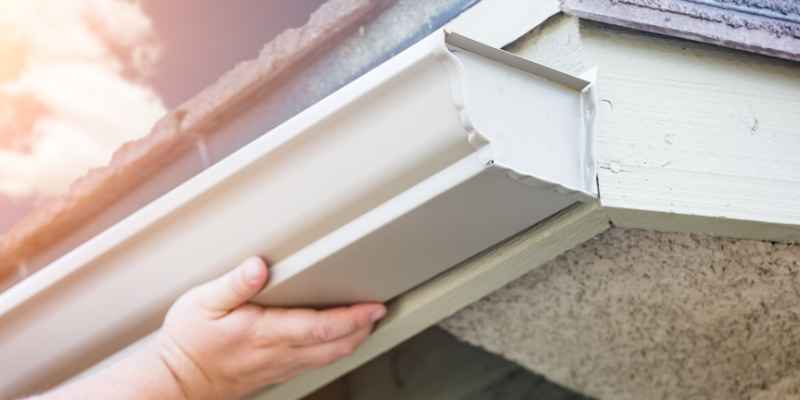To attach plastic to wood, use epoxy, super glue, or screws for a secure bond. Pre-drill holes for screws.
When working on DIY projects or repairs involving plastic and wood, knowing how to effectively attach the two materials is crucial. Whether you are building furniture, creating crafts, or fixing household items, understanding the proper techniques can ensure a strong and durable connection.
By following a few simple steps and using the right tools and materials, you can securely attach plastic to wood for long-lasting results. We will explore various methods and tips for successfully bonding plastic and wood together, allowing you to complete your projects with confidence and precision.
Introduction To Plastic And Wood Bonding
To attach plastic to wood, you need to choose the right adhesive based on the type of plastic and wood. Epoxy, polyurethane, and cyanoacrylate adhesives are often used for a strong and durable bond. Surface preparation, such as sanding and cleaning, is also important for successful bonding.
The Challenges Of Different Materials
Plastic and wood are two different materials with unique properties. They require different techniques to achieve a strong bond. The challenge lies in finding the right adhesive that can adhere to both materials.
Plastic is a non-porous material, which makes it difficult to bond with other materials. Wood, on the other hand, is porous and can absorb adhesives, making it easier to bond.
Why Strong Bonds Matter
A strong bond between plastic and wood is crucial for the longevity of the product. A weak bond can cause the plastic to come loose from the wood, which can be hazardous. It can also compromise the integrity of the product and lead to costly repairs or replacements.
To ensure a strong bond, it is important to choose the right adhesive and follow the proper bonding techniques. Some adhesives work better with certain plastics and woods, so it is important to do your research before starting the bonding process.
In conclusion, bonding plastic to wood can be challenging, but with the right adhesive and technique, a strong bond can be achieved. A strong bond is essential for the safety and longevity of the product, so take the time to do it right.
Materials You’ll Need
To attach plastic to wood, you will need a few materials including a drill, screws, sandpaper, and a plastic adhesive. Sand the wood surface, drill pilot holes, and then use the screws and adhesive to attach the plastic securely.
When it comes to attaching plastic to wood, it’s important to have the right materials on hand. Here are the key items you’ll need for a successful project:
Types Of Plastic Suitable For Bonding
Not all plastics are created equal, and some are better suited for bonding with wood than others. Here are some of the most common types of plastic you might use in your project:
- Polyethylene (PE): This plastic is lightweight and flexible, making it a good choice for applications where the plastic will be bent or shaped. However, it can be difficult to bond with adhesives.
- Polypropylene (PP): This plastic is similar to PE in terms of flexibility, but it is more rigid and has a higher melting point. It can be bonded with certain adhesives, but it may require some surface preparation.
- Polyvinyl chloride (PVC): This plastic is commonly used in construction and is relatively easy to bond with adhesives. However, it can be brittle and may not be suitable for all applications.
- Acrylic (PMMA): This plastic is clear and scratch-resistant, making it a good choice for applications where visibility is important. It can be bonded with certain adhesives, but it is more difficult to work with than some other plastics.
Choosing The Right Wood
The type of wood you choose will also play a role in how well your plastic adheres. Here are some factors to consider when selecting wood for your project:
- Surface texture: Smooth, flat surfaces are generally easier to bond with plastic than rough or uneven surfaces.
- Density: Denser woods like oak or maple may be more difficult to bond with plastic than softer woods like pine or cedar.
- Moisture content: Wood that is too wet or too dry can make it difficult for adhesives to bond with the plastic. Aim for wood with a moisture content of around 6-8%.
With the right materials and preparation, attaching plastic to wood can be a simple and effective way to enhance your DIY projects.
Prepping The Surfaces
When it comes to attaching plastic to wood, proper surface preparation is crucial for ensuring a strong and long-lasting bond. Prepping the surfaces involves a few key steps that will help to enhance adhesion and improve the overall quality of the attachment. In this section, we will discuss important tips for cleaning and sanding the surfaces, as well as surface treatments that can be applied to enhance adhesion.
Cleaning And Sanding Tips
Cleaning the surfaces is the first step in prepping plastic and wood for attachment. Here are some tips to ensure a clean surface:
- Remove any dirt, dust, or debris from both the plastic and wood surfaces using a soft brush or cloth.
- Use a mild detergent or soap and water solution to remove any grease, oil, or other contaminants that may affect the adhesion.
- Rinse the surfaces thoroughly with clean water and allow them to dry completely.
After cleaning, sanding the surfaces helps to create a rough texture, providing better grip and adhesion for the adhesive or fasteners. Follow these sanding tips:
- Use fine-grit sandpaper (around 120-180 grit) to sand both the plastic and wood surfaces.
- Sand in a back-and-forth motion, applying even pressure to achieve a smooth and even finish.
- Wipe away any sanding dust with a clean cloth or brush.
Surface Treatments For Enhanced Adhesion
In addition to cleaning and sanding, applying surface treatments can further enhance the adhesion between plastic and wood. Here are some treatments to consider:
- Priming: Applying a primer specifically designed for plastic and wood can improve the bond strength and durability of the attachment.
- Adhesion Promoters: These products help to create a chemical bond between the plastic and wood surfaces, enhancing adhesion.
- Epoxy Resin: Using an epoxy resin as an adhesive can provide excellent bonding strength, especially for larger and heavier attachments.
- Double-Sided Tape: For temporary or lightweight attachments, double-sided tape with a strong adhesive can be an effective option.

Selecting The Right Adhesive
Selecting the right adhesive is crucial when it comes to attaching plastic to wood. The adhesive you choose will determine the durability and strength of the bond between the two materials. In this section, we will explore two popular options: epoxy resins and polyurethane glues.
Epoxy Resins For Durable Bonds
Epoxy resins are widely used for their ability to create strong and durable bonds between plastic and wood. They consist of two components – the resin and the hardener – which must be mixed together in the correct proportions before application. The mixture is then applied to the surfaces to be bonded, and the adhesive cures over time, forming a solid and long-lasting bond.
Epoxy resins offer several advantages when attaching plastic to wood:
- High strength: Epoxy resins provide exceptional bonding strength, ensuring a reliable connection between the plastic and wood.
- Water resistance: Once cured, epoxy resins are highly resistant to water, making them suitable for both indoor and outdoor applications.
- Versatility: Epoxy resins can bond a wide range of plastics to wood, including polyethylene, PVC, acrylic, and more.
Using Polyurethane Glues
Polyurethane glues are another popular choice for attaching plastic to wood. These glues are known for their strong bonding capabilities and flexibility. Polyurethane glues work by reacting with moisture, so it is important to ensure the surfaces are clean and free from any contaminants before application.
Here are some key advantages of using polyurethane glues:
- Flexible bond: Polyurethane glues create a flexible bond that can withstand movement and vibrations, making them suitable for applications where the materials may experience stress or expansion.
- Gap-filling properties: Polyurethane glues have excellent gap-filling properties, allowing them to fill in irregularities and gaps between the plastic and wood surfaces.
- Moisture resistance: Once cured, polyurethane glues provide good resistance to moisture, ensuring the bond remains strong even in humid environments.
When selecting an adhesive, consider the specific requirements of your project, such as the type of plastic and wood involved, the intended use, and the environmental conditions. It is also essential to follow the manufacturer’s instructions for proper application and curing of the adhesive to ensure the best results.
Step-by-step Bonding Process
When attaching plastic to wood, a step-by-step bonding process is essential for a strong and durable bond. By following the right techniques, you can ensure a secure attachment that will withstand various conditions. Let’s delve into the process of bonding plastic to wood, covering the essential steps to achieve a reliable and long-lasting bond.
Applying The Adhesive
Begin by selecting a high-quality adhesive suitable for bonding plastic to wood. Apply a thin, even layer of the adhesive onto the clean and dry surface of the wood. Similarly, apply the adhesive to the plastic component that needs to be attached. Use a brush or nozzle to ensure precise application of the adhesive, covering the entire bonding surface.
Clamping For Success
Once the adhesive has been applied to both the wood and plastic surfaces, carefully position the plastic component onto the wood in the desired location. Use clamps to secure the two materials together, applying even pressure along the bond line. Ensure that the clamps are positioned to exert uniform pressure, facilitating optimal adhesion between the plastic and wood.
Curing Time And Conditions
To attach plastic to wood, it’s crucial to consider the curing time and conditions for the adhesive. Ensure a clean, dry surface and use a strong, waterproof glue suitable for both materials. Allow sufficient curing time as per the manufacturer’s instructions for a secure and durable bond.
Ideal Temperature And Humidity
Wood to plastic attachment cures best under specific temperature and humidity conditions.
How Long To Wait Before Handling
Waiting time before handling the plastic-wood bond is crucial for its strength.
Ideal Temperature And Humidity
Wood to plastic attachment cures best under specific temperature and humidity conditions.
How Long To Wait Before Handling
Waiting time before handling the plastic-wood bond is crucial for its strength.
Finishing Touches
To attach plastic to wood, start by drilling pilot holes in the plastic and wood. Use screws to secure the plastic to the wood, ensuring a tight fit. For a clean finish, consider using adhesive or decorative caps to cover the screws.
This method provides a secure and polished attachment for various DIY projects.
Trimming Excess Material
After attaching plastic to wood, trim any excess material carefully to ensure a neat finish.
Painting Or Sealing The Bond
Enhance the appearance and durability by painting or sealing the bond between plastic and wood.
Maintenance And Repair Tips
For attaching plastic to wood, ensure to use adhesive specifically designed for both materials. Clean surfaces thoroughly before applying adhesive to ensure a strong bond. Consider using screws or nails for additional support, especially for heavy-duty applications.
Maintenance and Repair Tips for attaching plastic to wood are crucial to ensure lasting bonds. Regular checks for bond integrity and repairing weakened bonds are key aspects of proper maintenance.
Regular Checks for Bond Integrity
Repairing Weakened Bonds
Regular Checks for Bond Integrity
– Inspect bonded areas for cracks or looseness.
– Ensure surfaces are clean before reattaching.
– Use adhesive strength indicators for assessment.
Repairing Weakened Bonds
– Apply fresh adhesive to reinforce weak spots.
– Clamp together until adhesive sets properly.
– Sand down uneven surfaces for smoother bonds.
Alternative Attachment Methods
When attaching plastic to wood, there are alternative methods to consider aside from traditional approaches. These methods offer versatility and strength in securing the two materials together.
Mechanical Fastening Options
One effective method is using screws to secure plastic to wood. It provides a sturdy hold and is suitable for structural applications. Nails are also a viable option for lighter-duty projects.
Brackets and clips can be used for a more discreet attachment method, suitable for projects where the fasteners need to be hidden from view. This option is ideal for aesthetic purposes.
When To Use Adhesive Tapes
Adhesive tapes are a convenient option when a strong bond is required without visible fasteners. They work well for lightweight applications and offer a clean finish without the need for drilling holes.
For temporary attachments or projects where disassembly may be required, double-sided tapes provide a secure yet removable solution. They are easy to apply and offer a quick bonding process.
Safety Considerations
When working with plastic and wood, it’s crucial to prioritize safety considerations. Understanding how to handle chemicals safely and properly dispose of materials is essential to prevent accidents and protect the environment.
Handling Chemicals Safely
When attaching plastic to wood, handling chemicals safely is paramount. Always wear protective gloves and a mask when working with adhesives or solvents. Ensure proper ventilation in the work area to minimize exposure to fumes. Store chemicals in a cool, dry place away from direct sunlight and heat sources.
Disposal Of Materials
Proper disposal of materials is crucial for environmental protection. Dispose of plastic packaging and waste in designated recycling bins to prevent pollution. When discarding wood scraps, consider repurposing them for other projects or use them as fuel for fires in fire-safe environments.
Common Mistakes To Avoid
To attach plastic to wood successfully, avoid these common mistakes: not roughening the surface, using the wrong adhesive, applying too much glue, not allowing proper drying time, neglecting to clamp the materials securely, and skipping thorough cleaning beforehand. These oversights can lead to weak bonds and project failure.
Overapplication Of Glue
One of the most common mistakes people make when attaching plastic to wood is overapplying glue. While it may seem logical to use more adhesive for a stronger bond, excessive glue can actually weaken the connection and lead to messy results. When applying glue, remember that a little goes a long way. It’s important to use just enough to create a secure bond without excess oozing out.
Ignoring Manufacturer’s Instructions
Another mistake to avoid when attaching plastic to wood is ignoring the manufacturer’s instructions. Each type of plastic and adhesive has specific guidelines provided by the manufacturer for optimal results. These instructions may include recommended application techniques, curing times, or precautions to take. It’s crucial to carefully read and follow these instructions to ensure a successful and durable attachment.
Real-life Applications
To attach plastic to wood, consider using epoxy or super glue for a strong bond. For a more secure connection, drilling and screwing the materials together can also be effective. Another option is to use adhesive tapes specifically designed for plastic and wood surfaces.
DIY Projects Examples
One of the most common real-life applications of attaching plastic to wood is in various DIY projects. Whether you’re a craft enthusiast or a homeowner looking to spruce up your space, there are countless opportunities to utilize this bonding technique.
Here are a few popular DIY projects examples:
- Creating custom furniture pieces: Plastic can be attached to wooden frames to create unique and stylish furniture items such as chairs, tables, and shelves. This combination not only adds visual appeal but also enhances the durability of the furniture.
- Building outdoor structures: Plastic panels can be easily attached to wooden frames to construct sheds, gazebos, or pergolas. This not only provides protection from the elements but also offers a cost-effective alternative to traditional building materials.
- Designing decorative accents: Wood and plastic can be combined to create decorative accents like wall art, photo frames, or planters. This allows you to showcase your creativity while adding a touch of elegance to your living space.
Industrial Uses Of Plastic-wood Bonds
The attachment of plastic to wood also finds extensive applications in various industrial sectors. This reliable bonding technique offers numerous advantages, making it a preferred choice for industrial purposes.
Here are some notable industrial uses of plastic-wood bonds:
- Manufacturing of composite materials: Plastic and wood can be combined to form composite materials that possess the desirable properties of both materials. These composites find applications in industries such as construction, automotive, and aerospace.
- Production of packaging materials: Plastic films or sheets can be securely attached to wooden pallets or crates, ensuring the safe transportation of goods. This combination offers excellent strength and protection against external impacts.
- Creating durable fixtures: Plastic components can be attached to wooden structures to create fixtures such as display stands, signage, and industrial shelving. This combination provides stability, versatility, and longevity required in industrial environments.
Whether you’re embarking on a DIY project or exploring industrial applications, attaching plastic to wood opens up a world of possibilities. From enhancing the aesthetics of your home to meeting the demands of various industries, this bonding technique proves its versatility and effectiveness.

Frequently Asked Questions
How Do I Attach Plastic To Wood Securely?
To securely attach plastic to wood, use screws or nails specifically designed for both materials. Predrill holes in the plastic to prevent cracking, and use a pilot hole in the wood to ensure a secure fit.
What Type Of Adhesive Works Best For Plastic To Wood?
For a strong bond between plastic and wood, choose a high-quality epoxy adhesive. Epoxy is durable, water-resistant, and provides excellent adhesion for joining these two materials together effectively.
Can I Use A Staple Gun To Attach Plastic To Wood?
A staple gun can be used to attach thin, flexible plastic to wood. However, for thicker or rigid plastic, it’s best to use screws, nails, or adhesives to ensure a secure and long-lasting attachment.
Conclusion
Attaching plastic to wood can be done effectively using various methods and techniques. Whether it’s through adhesive bonding, mechanical fasteners, or thermal welding, the key is to choose the right approach for your specific project. By following the tips and guidelines outlined in this blog post, you can achieve a strong and durable bond between plastic and wood.

